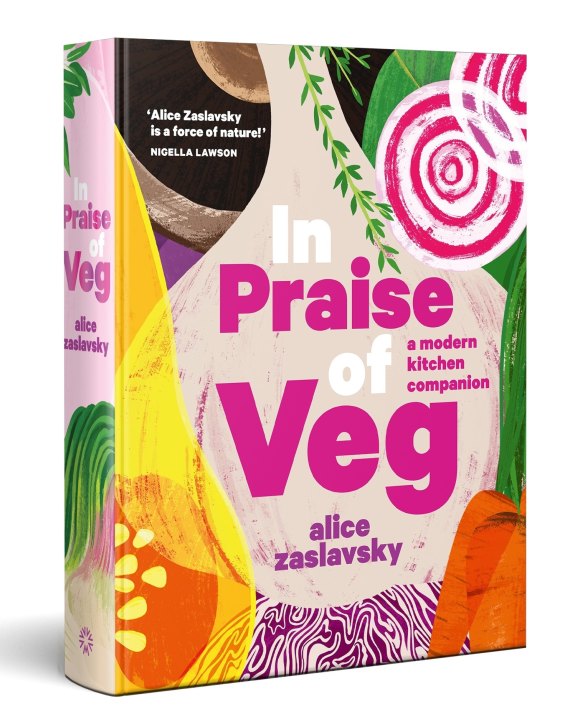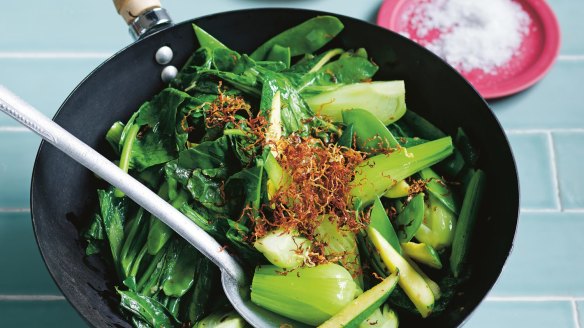Four vegetable-rich recipes from Alice Zaslavsky's new cookbook
Updated , first published

Food writer and former teacher Alice Zaslavsky brings the saying "eat the rainbow" to life in her exuberant, inspiration-rich cookbook, In Praise of Veg. Chapters are arranged by vegetable colour, beginning with white (cauliflower, daikon, parsnip and co) and ending with light green (celery, lettuce, peas), scooping up recipes and ideas for yellow, orange, red, purple, brown and dark green vegies along the way.
Here are four to try.

Keralan fried cauliflower with coconut chutney
Puffy popcorn pieces of cauliflower, warmed and wonderful with the spices of South India, complete with a quick and easy coconut chutney. These are already gluten-free and can easily be turned vegan by using coconut yoghurt for dipping. Serve as a stunning share-plate.
INGREDIENTS
- ½ head of cauliflower
- 150g (1 cup) chickpea flour
- 75g (½ cup) rice flour
- ¼ tsp baking powder
- 1 tsp salt flakes
- 2 tsp ground turmeric
- 2 tsp Kashmiri chilli powder
- 2 tsp mild curry powder
- 250ml (1 cup) very cold soda water
- 1 garlic clove, finely grated
- 1 tsp finely grated fresh ginger
- rice bran oil, for shallow-frying
- 3 curry leaf branches, washed and patted dry
- coriander leaves, to garnish
- 1-2 limes, cut into wedges
- Greek-style yoghurt, to serve
Coconut chutney (makes 1½ cups)
- 100g coconut flesh (or shredded coconut)
- 1½ tbsp coconut oil
- 1 tsp cumin seeds
- 1 tsp black mustard seeds
- 1 tsp chilli flakes
- 20 curry leaves, washed and patted dry
- 1 green chilli, chopped
- 1½ tsp tamarind puree
- 1 tsp brown sugar, or to taste
- 1 bunch of coriander, chopped
METHOD
- Remove and thinly slice the core from the cauliflower and set aside. Cut or tear the rest of the cauliflower into small florets about 3-4cm in size. Pick the leaves and keep these for frying also.
- In a large bowl, combine the chickpea flour, rice flour, baking powder, salt flakes and 1 teaspoon each of the turmeric, chilli powder and curry powder. Create a well in the middle, add the soda water, garlic and ginger, whisking out any lumps. Add the cauliflower florets and mix to coat. Chill for at least 15 minutes, or up to 1 hour.
- To make the coconut chutney, place the coconut in a bowl and cover with just-boiled water. Stand for 5 minutes to soften. Meanwhile, place the coconut oil, cumin and mustard seeds, chilli flakes, curry leaves and reserved cauliflower core slices in a frying pan over medium–high heat and cook for 3–4 minutes, or until the mustard seeds begin to pop and the cauliflower is softened. Transfer to a blender, along with the remaining chutney ingredients and drained coconut. Whiz until smooth and combined, adding 1 tablespoon of water at a time to loosen. Season to taste and set aside.
- Heat 3cm of rice bran oil in a wok or saucepan over high heat to 180C; a little batter added to the oil shouldn't take longer than 30 seconds to turn golden brown. Carefully add the well-dried curry leaf branches (they'll make a loud noise!) and cook for 30‑seconds, or until crisp. Drain on paper towel.
- Working in batches, add the cauliflower florets and leaves to the hot oil after shaking away the excess batter and cook for 3-4 minutes, or until golden. Drain on paper towel.
- Strain one-quarter of the cooking oil into a cold saucepan, leaving a 5mm shimmer of oil in the pan. Return the pan to the heat with the remaining spices and cook for 1 minute, or until foaming. Add all the fried cauliflower and cook, stirring, for 3 minutes, or until coated and golden. Transfer to a serving platter and scatter with the crispy curry leaves and coriander. Serve with the coconut chutney, lime wedges and yoghurt.
Serves 4-6 as a starter

Saffron orzo with charred deli artichokes
Some dishes are family heirlooms, others happy accidents, while some are simply divine inspiration. This one is the latter. And when I say "divine", I truly mean it. Saffron and globe artichoke are two of Greece's (many!) gastronomic gifts to the world. If you're to believe Greek mythology, it's Zeus himself we have to thank for the artichoke, after he transformed a homesick goddess into a thistle. Here, through time and heat, the thistle is returned to her golden glory, resting on a bed of unctuous orzo – or kritharaki as it is known in Greece – dappled with the sunshine glow of saffron. Aptly, Zeus was said to have slept on a bed of saffron, so you could say that this dish is a reunion of sorts for the king of Olympus and his ex. Awkward.
INGREDIENTS
- 80ml (⅓ cup) olive oil
- 6 cooked artichokes with stems (see tip), halved lengthways
- 2 French shallots, finely chopped
- 1 bunch of parsley, stems finely chopped, leaves picked and chopped
- 330g (1½ cups) orzo (or risoni)
- 750ml (3 cups) vegetable stock
- a good pinch of saffron threads
- 2 tsp finely chopped preserved lemon
- 60g (½ cup) hazelnuts, lightly toasted, then roughly chopped
METHOD
- Heat 2 tablespoons of the olive oil in a large frying pan over high heat. Add the artichokes cut side down and cook, without touching, for 4 minutes, or until charred and golden. Remove and drain on paper towel.
- Add the remaining oil to the pan over medium-low heat. Add the shallot and parsley stems and cook for 4 minutes, or until softened. Add the orzo and cook, stirring, for 2 minutes, or until glossy and slightly toasted. Pour in the stock and bring to the boil, then reduce the heat to low. Add the saffron, then cover and cook for 12-15 minutes, or until the orzo is cooked through. Stir in the preserved lemon.
- Place the artichokes on top of the orzo, face side up. Cover and cook for 3 minutes to warm through.
- Transfer to a serving dish and scatter with the chopped parsley and hazelnuts. Serve warm or cold.
Serves 4
Tip Most continental delis sell two types of marinated artichokes – one preserved in oil, which tends to be just the heart, the other most likely kept in brine, with more of the leaf intact. Whichever you choose is up to you. Jarred artichokes are more than a suitable replacement if these fancy ones are not forthcoming.
Shortcut Instead of orzo, use instant couscous, frying up the artichokes while the kettle (or vegetable stock) comes to the boil. Stir saffron into the couscous just before pouring the hot liquid over it.
Double duty This dish is one step away from being a pasta salad. Chop or tear the marinated artichoke into chunks, crumble some feta on top and serve cold – it's a fantastic "bring a plate" or desk-lunch option.

Lau's vegetables with fresh ginger
I've been obsessed with this dish since my first visit to Lau's Family Kitchen in St Kilda many moons ago. I asked Gilbert if he wouldn't mind if I borrowed his recipe, and he invited me straight into the kitchen to see how it was made. My husband has requested that we have this dish at least once a week at home, and I'm sure it'll have a similar effect on your loved ones, too.
INGREDIENTS
- 500g assorted green vegetables, such as zucchini, snow peas, sugar snap peas, baby spinach, bok choy, broccolini, gai lan (Chinese broccoli) and wombok, chopped into bite-sized pieces
- 60ml (¼ cup) sunflower oil
- 1 thumb-sized piece of fresh ginger, peeled and roughly chopped
- 60ml (¼ cup) vegetable stock
- a pinch of salt flakes
- a pinch of sugar
Fizzy ginger (optional)
- 60ml (¼ cup) sunflower oil
- 1 thumb-sized piece of fresh ginger, peeled and finely shredded
METHOD
- Blanch any harder vegetables such as gai lan or broccolini in a saucepan of vigorously boiling water – about 2 minutes for the stalks, then add any florets and cook for another minute, before plunging them straight into a bowl of iced water to stop them overcooking.
- Drain once cooled, then spin to ensure there's no water left on them, as any water will spit when you fry.
- Meanwhile, heat a wok or large, wide-based frying pan until smoking hot. (If you're cooking on an induction stovetop, like me, this can take 15-20 minutes.) If making the fizzy ginger, pour the oil into the pan, then add the ginger and cook for 1-2 minutes, or until the bubbles subside and the ginger is crisp. Drain on paper towel.
- Heat the sunflower oil in the pan. Toss in the ginger, then, working in batches, add the vegetables according to their density – woody/stalky vegies first, then peas of any kind, zucchini or bok choy, finishing with any fine leaves, transferring each batch to a plate as you go.
- Return all the vegies to the pan, then pour the stock over and let it absorb a little. Sprinkle in the salt and sugar, give it one final toss, then tip straight out of the pan and serve immediately.
Serves 4
Tip Baby bok choy is perfect for this dish, but requires a really thorough wash between all the layers. Direct your tap through the heart once you chop the leaves off and quarter, using your fingers to agitate.
Shortcut If you've no time for blanching, give any harder vegies a vigorous boil for a minute, before transferring straight into the hot wok. Or just use softer veg for the quickest version.

Golden bundt cake
When we were photographing this cake, I sent some home with my publisher, whose daughter declared, "It doesn't taste like a vegetable cake", which I would agree with – because most of the time, people who put vegetables in a cake do it surreptitiously, trying to "sneak in a serve". Here, patty pan squash – or zucchini if you'd prefer – is celebrated with reckless abandon, to the point that you can still see flecks of yellow and green through the moist, velvety sponge.
INGREDIENTS
- 20g unsalted butter, melted
- 250g (2 cups) coarsely grated patty pan (baby yellow) squash or zucchini (see tip)
- 110 g (½ cup) caster sugar
- finely grated zest of 1 lemon, plus 80 ml (⅓ cup) lemon juice
- 1 tbsp finely chopped lemon thyme leaves (or regular thyme leaves, if you must)
- 180ml (¾ cup) light extra virgin olive oil, plus extra for greasing
- 3 eggs
- 250ml (1 cup) buttermilk
- 170g (¾ cup) brown sugar
- 45g (½ cup) desiccated coconut
- 375g (2½ cups) self-raising flour
- ½ tsp salt flakes
- 175g (1½ cups) icing sugar
Dehydrated squash flowers
2 patty pan (baby yellow) squash, thinly sliced using a mandoline or sharp knife
METHOD
- Preheat the oven to 160C fan-forced (180C conventional). Grease a 25cm fluted ring (bundt) tin with the melted butter, then transfer to the fridge to chill and set.
- Place the grated squash, caster sugar, lemon zest and lemon thyme leaves in a bowl and mix to combine. Stand for 10 minutes to macerate.
- Add the oil, eggs, buttermilk and brown sugar to the bowl, mixing well. Add the coconut, then sift in the flour and salt. Use a wooden spoon to combine, without overmixing.
- Transfer to your cake tin and bake on the middle rack of the oven for 1 hour, or until a skewer inserted in the cake comes out clean. Leave to cool in the cake tin on top of a wire rack for 10 minutes, then invert the cake onto the wire rack to cool completely.
- If making the dehydrated squash flowers, flick the oven on to 100C fan-forced (120C conventional). Place the squash slices on a wire rack so that the slices will droop over. Pop into the oven for 20 minutes, or until dried into frilly "flowers".
- Meanwhile, get the icing going. Place the icing sugar in a bowl, add 60ml (¼ cup) of the lemon juice and mix to combine. Add more lemon juice, a teaspoon at a time, to achieve a smooth, spoonable icing consistency.
- Spoon the icing over the cooled cake, then garnish with the squash flowers. This cake keeps extremely well, covered loosely with beeswax wrap or foil and stored on the bottom shelf of your fridge. Not that you'll have much left, mind you.
Serves 8
Tip If you're using zucchini but still want to keep the paler sponge, just peel off the skin, or leave it on for maximum veg cake realness.
Shortcut The icing is optional, as are the dehydrated "flowers". Try dusting the cake with icing sugar instead, decorating with fresh lemon thyme leaves.
This is an edited extract from In Praise of Veg by Alice Zaslavsky, Murdoch Books, $59.99. Photography by Ben Dearnley. Buy now
Appears in these collections
From our partners
Original URL: https://www.watoday.com.au/goodfood/four-vegetablerich-recipes-from-alice-zaslavskys-new-cookbook-20201028-h1rqzb.html